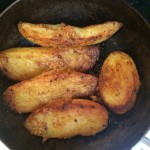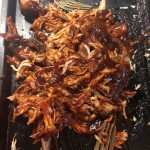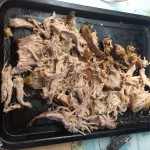Pulled pork, along with BBQ ribs, burgers, fries and milkshake, about as quintessential American comfort food as it’s possibly to get. After years where Brits visiting American enjoyed this well-kept secret (as far as our own country goes, at least) on our travels, but suddenly it’s become flavour of the month, literally and metaphorically. Everywhere you look there are pulled pork sandwiches, pulled pork burgers, even a pulled pork lasagne!
Given how easily this food can be commoditised by the mass manufacturing industry, constantly on the look out for some dazzling new flavour to add to their production lines, maybe that isn’t such a surprise – but given how much of a treat pulled pork can be you’d be silly not to take the more satisfying and tastier step of cooking your own. Not difficult but definitely repays the effort.
Choose your pork
First thing is to pick your meat. As always, the higher quality free-range product will always be better than the supermarket equivalents, so take the time to find a really excellent pork butcher who sells you top notch pig. The recipe generally requires shoulder of pork, chosen for its fatty content and the fact that it thrives from long, slow cooking. In this case, given that it was just son and me to cook for, I tried it with a neck fillet of pork larded with some extra strips of pork fat. Sounds odd but it works fine and makes two generous portions, with enough left over for a tasty sandwich.
Dry rub vs wet rub
Next thing is the rub. Americans become deadly serious when you talk through the merits of different rubs to smother on their meat. There are various schools of thought, some favouring a dry rub and others a paste. In this case I plumped for the latter, and can’t complain about how it turned out. Contents were as follows:
- Mustard powder
- Garlic (you could try powder though here I used ready-minced)
- Sea salt and pepper
- Smoked paprika
- Turmeric
- Cayenne
- Cumin
- Allspice
- 1 tsp Chilli oil
- 1 tbsp Cider vinegar
- 1 tsp Honey
Mix these ingredients together into a thick paste and smear liberally over the pork. Cover with cling film and chill for a couple of hours minimum.
Cook & shred the pork
Take some aluminium foil and use it to wrap up the pork well. Pop it in an oven tin and cook on very low heat for a long time. In my case, I used the bottom oven of the Aga and cooked it overnight.
About an hour before serving, take the pork from the oven and leave it to rest for a good 10-15 minutes, by which time it should be tender as the day is long. Then take two sturdy forks and shred it to tear apart the fibres of the meat, which should be pretty easy and leave it looking like the dry shot above.
Make the BBQ sauce
You could use any one of a thousand commercial versions, but there is something way more satisfying about making your own. In this case I made a different recipe to that used for BBQ ribs, which is far more liquid and reduces down to a sticky mess. In this case, experiment to find the combination and quantities of ingredients that satisfy you, but you can’t go far wrong! My personal secret ingredient is the tamarind sauce.
- Tomato ketchup
- Garlic purée
- Worcester sauce
- Dark soy sauce
- Mustard powder
- Honey
- Smoked paprika
- Chilli sauce
- 1-2 tbspns of cider vinegar
- Tamarind sauce
- Chilli salt
- Black pepper
Mix to a fairly moist sauce.
Assemble & serve
Add the sauce to the pork and mix well. Then put back in the slow oven for another 5-10 minutes. It will reduce to stickiness but should keep the meat flavoursome and moist.
You could serve it in a crusty bun with fries or wedges and salads. In this case my son fancied roasties, so I made special roast spuds, coated in chilli and garlic, plus another dose of the chunky guacamole that went down so well recently.
Assemble on the plate and enjoy!








